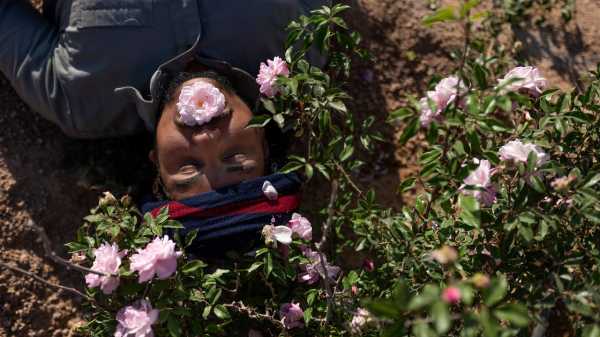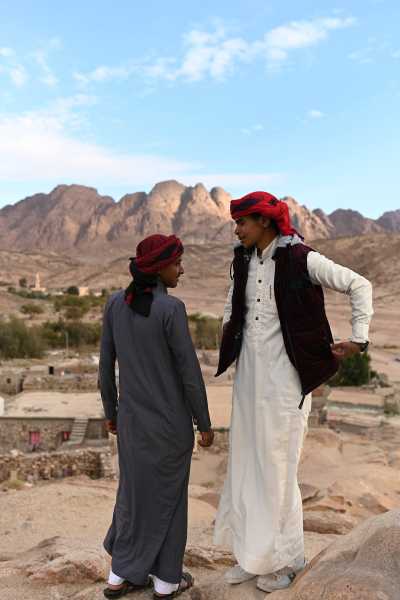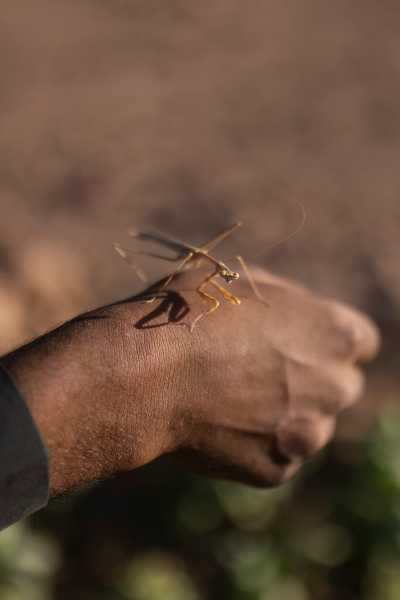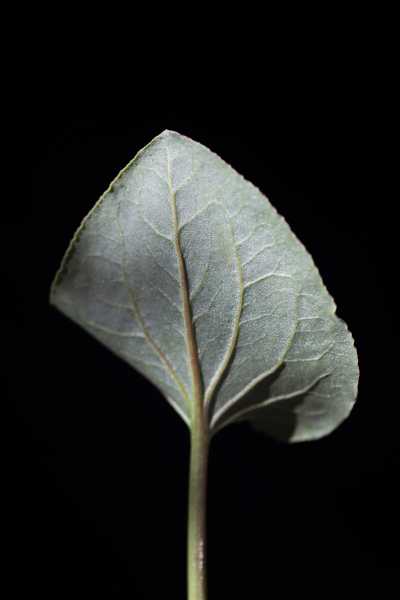
Save this storySave this storySave this storySave this story
In 2012, the Egyptian photographer Rehab Eldalil began photographing the Bedouin Jebeleya tribe, whose ancestors have lived in the foothills of Mt. Sinai, in Egypt, for more than a thousand years. The resulting series, “The Longing of the Stranger Whose Path Has Been Broken,” traces the relationship between the tribe and St. Catherine, the town where they live, which has often been undermined by outside forces: in the twentieth century, by British colonization and Israeli occupation, and, today, by urbanization. “I tried to depict a dance between the community and the land,” Eldalil told me recently. Her photographs portray St. Catherine and its residents as intimates. In one image, the outlines of footprints are drawn onto a rock, evoking the Bedouin practices of using footprints in marriage proposals and leaving markings that chart the path of a trek. Elsewhere, the silhouettes of figures flirt with the landscape, their jellabiyas casting long shadows on craggy paths.


Eldalil was born in Cairo in 1989. In the late nineties and early two-thousands, she and her family lived in the United States while her father—a veteran who had been stationed in Sinai during the 1973 Arab-Israeli war—taught engineering at the University of Maryland. The summer after 9/11, amid growing Islamophobia, the family moved back home. When the Egyptian Revolution erupted, in 2011, Eldalil was a senior in college who planned to pursue nature-and-wildlife photography professionally; the revolution ignited an interest in cultural identity that led her to explore the possibility of photographing Bedouin communities in Sinai. Eldalil had grown up visiting the region with her father, who taught her about the Bedouins’ role in resisting occupation. The conception of the Bedouin which Eldalil inherited from her father diverged from the way the communities are represented in Egyptian society, which often casts them as traitors for having remained in Sinai during the occupation, or ridicules them for wearing traditional clothes in urban contexts.

In 2014, Eldalil settled in St. Catherine, where she would live for the next seven years. With the help of tribe elders, she established a community center that would grow into a volunteer-run clinic. She stayed because she felt, she said, a “spiritual connection” to the place. On one of her earliest trips alone, she spoke to an elder named Sheikh Jamil who was curious about her last name—the Arabic word for “guide.” Sheikh Jamil told her that, four generations ago, an Eldalil family had resided in Sinai before settling in Zagazig, a city north of Cairo, where her father was born. Initially, when Eldalil asked her father about the family’s origins, she was met with silence. “I come from a family with generational trauma: a grandfather imprisoned for years for advocating for Palestinian rights. A father, the eldest of six, was forced as a young boy to take over his father’s role in the family, and by the age of 20 went to war,” she writes in the introduction to the book edition of “Stranger.” Eventually, her father told her that his mother’s family came from Palestine, and that his father had Bedouin ancestry from Sinai—information that Eldalil took as an explanation for why she felt so deeply tied to St. Catherine. In the absence of documents that could attest to her family’s Bedouin heritage, Eldalil sought to reconnect with her ancestors through the community, and her project took on a semi-autobiographical quality. (As she admits, the “stranger” of her series’ title, drawn from a line in a poem by a Jebeleya poet, Mahmoud Abu Hussein, refers to herself.)

One of the central questions that lingers throughout Eldalil’s series is that of what it might mean to depict Indigenous people without resorting to visual tropes that are entangled with a history of violence. Some of Eldalil’s first photographs of the Jebeleya featured unintentional echoes of images taken by photographers who came from the West, such as the American Colony, a utopian Christian sect based in Jerusalem which was composed of religious pilgrims from the United States and Sweden. In the late nineteenth and early twentieth century, the group operated a lucrative photo service. Its pictures feature what would now be recognized as Orientalist stereotypes: Bedouin men feeding camels, women in their traditional dress. Eldalil’s earliest photographs of St. Catherine sometimes struck a similar chord, depicting distant figures walking across desert landscapes, women posing alongside their children, or making bread. (In reality, today it is more usual to find Jebeleya women than men graduating from high school, going on to higher education, and becoming financially responsible for their families by taking on careers like nursing and working as shepherds.)

As Eldalil’s project grew, however, she began to be more conscious of ways to give her protagonists greater agency over how they were depicted. At first, many of the women Eldalil photographed were reluctant to have their images published because, in the past, Western tourists had taken photographs of them and posted the pictures online without their permission. (Bedouin women reserve the right to choose whether to reveal their faces to men outside of their tribe.) Eldalil ended up printing many of these women’s photographs on fabric and proposing that the women use embroidery—a traditional Bedouin craft—to reveal or conceal their faces as they desired.



Eldalil’s images suggest that belonging to St. Catherine entails not just dwelling on its soil but also accepting its mercurial nature, sometimes withholding and sometimes bountiful. In 2020, during the onset of the pandemic, a fortuitous flood broke a drought and transformed the land. Barren gardens began to bloom, bringing Eldalil’s photographs of dried-out valleys and orchards that Bedouin women had embroidered over with flowers to life. A photograph from that April features a young man named Moussa AlGebaly, who, in 2015, was part of the first cohort of Bedouins who were permitted to serve in the Egyptian military. AlGebaly poses in a garden that he planted with the tea flower, which is boiled by Bedouin women as a remedy for labor and menstrual pain. “There was no shame when he explained to me how this plant was used. And there was no shame in planting it,” Eldalil told me. In the photograph, AlGebaly lies in the garden wearing a new jellabiya, the purple flower in his mouth, his eyes blissfully closed.


In recent years, the Bedouins’ place in the Sinai has been endangered by the Egyptian government’s urbanization schemes and by its ongoing military conflict with insurgent groups. In 2022, the city center of St. Catherine was razed. There are plans for a ten-story hotel, and roads are being constructed over unspoiled valleys nearby. For now, members of the Jebeleya community living outside of the town center have been spared eviction. “Their fate is intertwined with that of the land,” Eldalil said. “To be removed from it is to erase their identity.” In one of Eldalil’s photographs, three women stand on a mound of rocks with their backs turned to the camera. In the distance, a transmission tower and power lines are visible. The women’s arms are outstretched, as if they are holding the landscape in an embrace, and it is embracing them in return.

Sourse: newyorker.com







